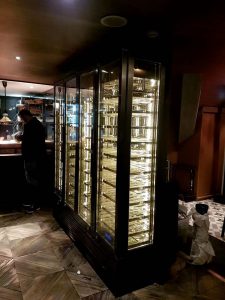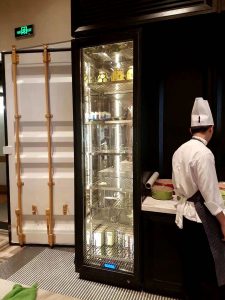Electrically heated glass
Product description:
Electrically heated glass, also known as heated glass or electrically conductive glass, is a type of glass that incorporates a transparent conductive coating and an electrical circuit to generate heat. This technology is used to prevent condensation, ice, and snow buildup on glass surfaces, making it particularly useful in various applications, including automotive, architectural, and even in some specialized industrial settings.
How It Works
Electrically heated glass typically consists of the following components:
Conductive Coating:
A transparent conductive layer, often made from materials like indium tin oxide (ITO), is applied to the glass. This coating allows electricity to pass through and generate heat uniformly across the surface.
Electrical Circuit:
Electrical connections are made to the conductive coating, creating a circuit. When a voltage is applied, the electrical current flows through the coating, producing heat due to electrical resistance.
Insulated Glass Units (IGUs):
In architectural applications, heated glass is often part of an insulated glass unit (IGU), which consists of two or more glass panes with a spacer in between, creating a sealed airspace. The heated glass is typically the inner pane in the IGU.
Heated glass Applications
Automotive
Windshields: Prevents ice and snow buildup, improving visibility and safety.
Rear Windows: Commonly used as defrosters to clear condensation and frost.
Side Mirrors: Prevents fogging and icing, enhancing rear visibility
Architectural
Windows and Facades: Prevents condensation on large glass surfaces in buildings, maintaining clear views and reducing maintenance.
Skylights: Keeps skylights clear of snow and ice, ensuring natural light entry.
Greenhouses: Maintains optimal temperatures and prevents frost on glass surfaces.
Specialized Industrial
Refrigerated Display Cases: Prevents condensation on glass doors in commercial refrigeration units.
Laboratories and Clean Rooms: Maintains clear vision panels by preventing condensation in controlled environments.
Antifogging electric heating glass, window electric heating glass, hollow electric heating glass, hot bending electric heating glass, toughened electric heating glass, laminated electric heating glass.
Electrically heated glass Benefits:
Improved Visibility and Safety:
In automotive applications, heated glass ensures clear visibility in adverse weather conditions, enhancing safety.
Comfort:
In buildings, heated glass can help maintain comfortable indoor environments by preventing cold drafts typically associated with large glass surfaces.
Energy Efficiency:
Reduces the need for additional heating or defrosting systems, potentially lowering energy consumption.
Aesthetic and Functional Design:
Maintains the visual clarity and aesthetic appeal of glass surfaces without the need for mechanical defrosting or dehumidifying systems.
Reduced Maintenance:
Minimizes the need for manual cleaning and defrosting, saving time and effort.
Available Applications:
Glass roofs, verandas, glass archways, domes, awnings, mezzanines, greenhouses, store fronts, and large picture windows. Also warmth and comfort can now be found in swimming pools, spas, saunas, cloak rooms, bathrooms and other humid areas, lobbies, atriums, and other indoor spaces found in homes, hotels, offices, commercial centers, boutiques and factories, whether in train stations, airports, cultural and sports fixtures, street furnishings or ship building. It is ideal for low-energy consumption construction.
Facades, roofing, bay-windows, awning, internal partitions, verandas, security glazing, glass floor… Depending on the application and the required functionality (heating, snow removal, anti-condensation), the power intensity and the glass dimensions are determined.
- electrically heated glass dor food display
- electricalldy heated glass dor display carbinet
Electrically heated glass features:
1. Defrosting function: after heated glass in power on state, the surface temperature of the glass rises (usually 35 ~ 40 ℃), keeping above the dew point of the air, so it prevents frosting and dewing on the surface of the glass.
2. Excellent optical performance:
the conductive wire and conductive film are used as heating medium to ensure that the glass has excellent light transmission performance and anti distortion performance, so that the driver can see clearly, truly and with high resolution through the glass.
3. Anti ultraviolet radiation function:
Float glass has high ultraviolet absorption capacity, and it can effectively prevent ultraviolet rays from entering the room and reduce the damage of ultraviolet rays to drivers and indoor facilities.
Electrically heated glass maintance:
Maintenance:
Collision with rigid objects should be avoided during use. When there are stains on the surface of the product that need to be cleaned, gently wipe it with clean soft material and alcohol.
Costs:
The cost of electrically heated glass varies widely based on the application, size, and complexity.
Considerations
Power Supply: Heated glass requires a continuous power source. In vehicles, this is typically integrated into the vehicle’s electrical system. In buildings, a dedicated electrical circuit is usually needed.
Energy Consumption: While electrically heated glass can reduce the need for other heating methods, it does consume electricity, which should be factored into energy usage considerations.
Durability and Maintenance: High-quality heated glass is durable, but regular maintenance and checks are recommended to ensure the electrical components remain in good working order.
Conclusion
Electrically heated glass is a versatile and practical solution for maintaining clear and ice-free glass surfaces in various applications. Its benefits in visibility, comfort, and maintenance make it an attractive option for automotive, architectural, and specialized industrial uses. While it comes with additional installation and energy costs, the advantages often outweigh these considerations, especially in environments where clear glass is crucial for safety and functionality.

